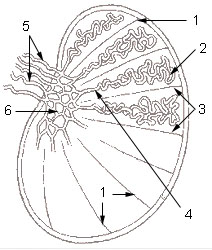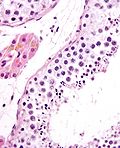Seminiferous tubule




The Seminiferous Tubules are a component of the male reproductive system that are located within the testes. They are the site of the germination, maturation, and transportation of the sperm cells within the male body. The epithelium of the tubule consists of a type of sustentacular cells known as Sertoli cells, which are a crucial part of spermatogenesis.
Structure[edit]
The seminiferous tubules are a coiled network of tubes that measure up to half a mile in length in each testis. They are lined with a layer of cells that progress through the stages of spermatogenesis to produce sperm. The tubules are surrounded by myoid cells that contract rhythmically to move the immature sperm towards the rete testis for further maturation.
Function[edit]
The primary function of the seminiferous tubules is the production of sperm. This process, known as spermatogenesis, involves the development of spermatogonia into mature spermatozoa. The process is facilitated by Sertoli cells, which provide nourishment and structural support for the developing sperm cells.
Clinical significance[edit]
Damage or disease affecting the seminiferous tubules can lead to infertility in males. Conditions such as varicocele, cryptorchidism, and certain genetic disorders can affect the function of the tubules and result in a reduced sperm count or poor sperm quality.
-
Longitudinal section through the left side of the scrotum and the left testis (seminiferous tubules visible in center, but not labeled).
-
Photomicrograph of section through rat testis, showing seminiferous tubules.
See also[edit]
Ad. Transform your life with W8MD's Budget GLP-1 injections from $75


W8MD offers a medical weight loss program to lose weight in Philadelphia. Our physician-supervised medical weight loss provides:
- Weight loss injections in NYC (generic and brand names):
- Zepbound / Mounjaro, Wegovy / Ozempic, Saxenda
- Most insurances accepted or discounted self-pay rates. We will obtain insurance prior authorizations if needed.
- Generic GLP1 weight loss injections from $75 for the starting dose.
- Also offer prescription weight loss medications including Phentermine, Qsymia, Diethylpropion, Contrave etc.
NYC weight loss doctor appointmentsNYC weight loss doctor appointments
Start your NYC weight loss journey today at our NYC medical weight loss and Philadelphia medical weight loss clinics.
- Call 718-946-5500 to lose weight in NYC or for medical weight loss in Philadelphia 215-676-2334.
- Tags:NYC medical weight loss, Philadelphia lose weight Zepbound NYC, Budget GLP1 weight loss injections, Wegovy Philadelphia, Wegovy NYC, Philadelphia medical weight loss, Brookly weight loss and Wegovy NYC
|
WikiMD's Wellness Encyclopedia |
| Let Food Be Thy Medicine Medicine Thy Food - Hippocrates |
Medical Disclaimer: WikiMD is not a substitute for professional medical advice. The information on WikiMD is provided as an information resource only, may be incorrect, outdated or misleading, and is not to be used or relied on for any diagnostic or treatment purposes. Please consult your health care provider before making any healthcare decisions or for guidance about a specific medical condition. WikiMD expressly disclaims responsibility, and shall have no liability, for any damages, loss, injury, or liability whatsoever suffered as a result of your reliance on the information contained in this site. By visiting this site you agree to the foregoing terms and conditions, which may from time to time be changed or supplemented by WikiMD. If you do not agree to the foregoing terms and conditions, you should not enter or use this site. See full disclaimer.
Credits:Most images are courtesy of Wikimedia commons, and templates, categories Wikipedia, licensed under CC BY SA or similar.
Translate this page: - East Asian
中文,
日本,
한국어,
South Asian
हिन्दी,
தமிழ்,
తెలుగు,
Urdu,
ಕನ್ನಡ,
Southeast Asian
Indonesian,
Vietnamese,
Thai,
မြန်မာဘာသာ,
বাংলা
European
español,
Deutsch,
français,
Greek,
português do Brasil,
polski,
română,
русский,
Nederlands,
norsk,
svenska,
suomi,
Italian
Middle Eastern & African
عربى,
Turkish,
Persian,
Hebrew,
Afrikaans,
isiZulu,
Kiswahili,
Other
Bulgarian,
Hungarian,
Czech,
Swedish,
മലയാളം,
मराठी,
ਪੰਜਾਬੀ,
ગુજરાતી,
Portuguese,
Ukrainian




